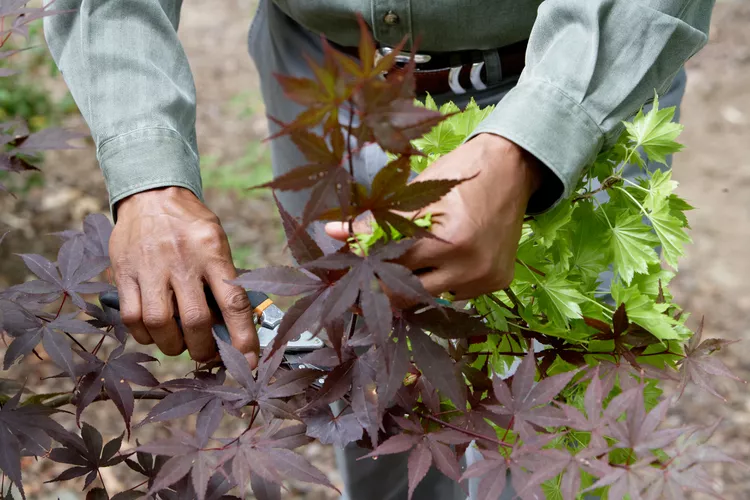Japanese maples have a multitude of attributes that make them perfect trees for shady landscapes. Some varieties boast eye-catching spring color, while others are bedecked with a riot of hues in fall. Leaf shape and texture range from traditional maple shapes to finely cut and lacey leaves. Their slow growth rate and relatively short stature make them great trees for small-space gardens, petite patio plantings, and narrow garden beds.
All their attributes are amplified with good pruning techniques. Here are 11 must-know tips for pruning Japanese maple trees properly so you can help them thrive for decades.
1. Balance is best.
Japanese maples have a growth pattern that gives an open, airy appearance. They don’t have a rounded outline like their cousins, red maples. Instead, their outline can best be described as natural but balanced. A well-pruned Japanese maple has similar sizes of branches on all sides, with some extending more than others while still maintaining a balanced appearance.
2. Prune for the long game.
Japanese maples grow slowly, often putting on less than 12 inches of growth a year. Pruning cuts made this year—and even next year—might not make a visible difference in the overall form and structure of the tree until three or four years down the road. Don’t lose heart or your pruners; your efforts will yield rewards in the form of a lovely layered specimen tree in time.
3. Use the right tools.
A pair of sharp garden pruners and medium-size loppers are usually all that is required to prune a Japanese maple. This slow-growing tree typically has small branches that are easily removed without having to break out a saw. If you need to remove a large branch, a small handsaw will get the job done. Whatever type of pruner you employ, be sure it is sharp. Dull pruners make rough cuts that heal slowly, creating entry points for pests and diseases.
4. Prune in late winter.
It is easiest to clearly see the form of a Japanese maple when the branches are leafless. Pruning toward the end of winter primes the tree for spring growth and reduces the chance of winter injury as temperatures start rising in early spring.
5. Study your tree.
Don’t bypass taking a long look at your tree from the bottom up and the inside out. Get an overall sense of how the branches are arranged, how the branches interact inside the tree, and the overall shape of the plant. Thoughtfully stepping back and examining the tree before wielding your pruners will help you make smarter pruning cuts.
6. Remove the obvious.
Prune away dead, diseased, and broken branches immediately, cutting them back to the nearest live branch. Prune away branches that are growing toward the interior of the tree, as well as those that are crossing each other.
7. Mind the branch collar.
The branch collar is the slightly swollen woody growth where a branch connects with the main trunk of a tree. When removing a branch, don’t cut into the branch collar. Instead, remove the branch to the outer edge of this area. The branch collar works to quickly seal the pruning wound, preventing pests and diseases from entering the tree.
8. Create layers.
After removing the dead, diseased, and broken branches, along with those that are crossing or growing toward the interior of the tree, prune to create layers. Japanese maples are most eye-pleasing when they are pruned so that individual branches create visible layers. The key to crafting the visible layers is the space between the branches.
Create space between branch layers by removing branches that are growing too vertically or too horizontally. Often, an offending branch doesn’t need to be cut all the way back to the trunk; cut it back to a side branch that is angled in the direction desired to create the layer.
9. Remove no more than 30 percent of the tree.
Ensure a Japanese maple has adequate resources to sustain itself by not removing more than 30 percent of the canopy during a season. If a tree needs significant pruning, spread the trimming over three years, removing one-third of the excess growth each year.
10. Expose the trunk.
Clip away twiggy growth along the main trunk, or trunks if the Japanese maple is a multi-stem tree. Removing this twiggy growth reveals the trunk, helping highlight the layered structure of the branches above. It can be helpful to wait until the tree is leafed out to better see the outcome of trimming off growth that obscures the trunk.
11. When in doubt, don’t cut.
Japanese maples are slow-growing trees. It takes them a few years to recover from a pruning job gone wrong. If you are unsure about a particular pruning cut, step back from the tree and get an overall sense of its shape and form. Put down the pruners and reexamine the tree with a fresh perspective in a few days if necessary.




















